Love of Rock Music Launched David McGough's Starry Career
by David Hackett, Sarasota Magazine
April 30, 2019
 Image by Barbara Banks
Article at SarasotaMagazine.com
Image by Barbara Banks
Article at SarasotaMagazine.com
FAME Photographs by David McGough - James Cox Gallery at Woodstock
PDF Version

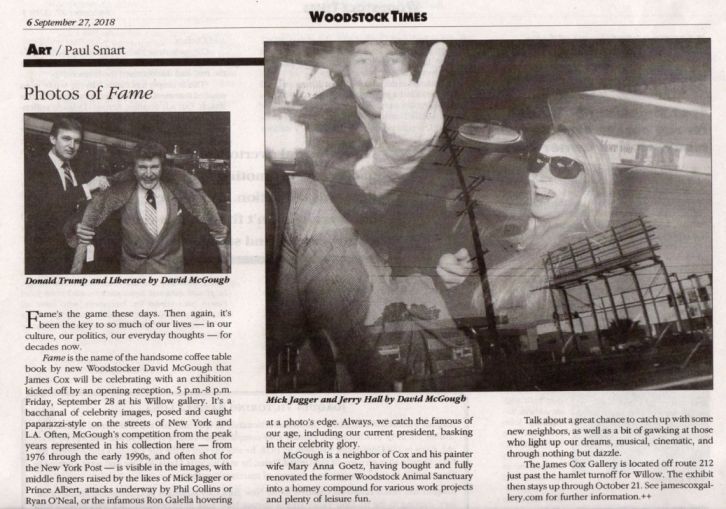
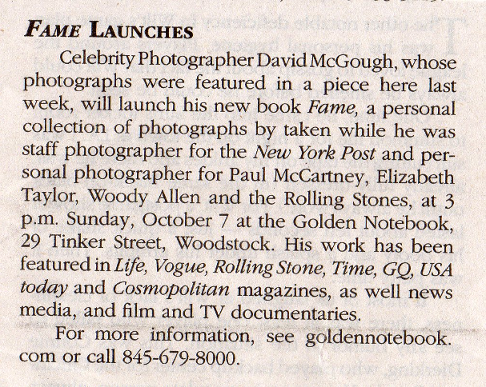
John Scher's career will be focus of new exhibit at Where Music Lives in Asbury Park

BY Jay Lustig | October 20, 2015
Original Article
Q & A with photographer / musician David McGough - one of New York's most important photojournalists
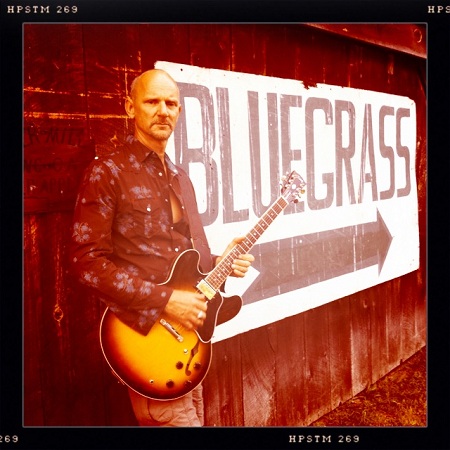
BY Michalis Limnios | POSTED: May 27, 2014
Original Article
PDF Version
Incredible Photos of William S. Burroughs With Mick Jagger, Warhol, and More
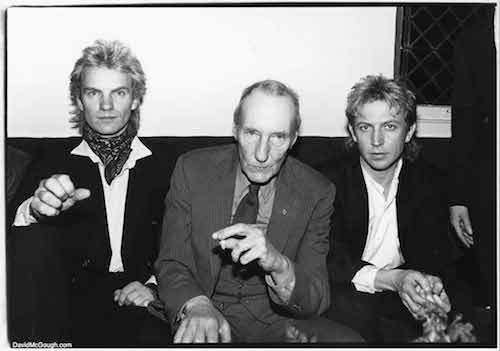 1985- Limelight nightclub party for Burroughs.
1985- Limelight nightclub party for Burroughs.
BY Barry Miles | POSTED: January 29th, 2014
Original Article
Fans come out for Rock �N� Blues Fest at bergenPAC in Englewood
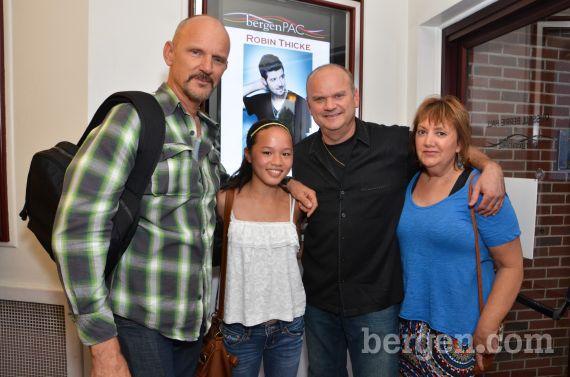 David McGough, Grace McGough, Michael McGough and Liz McGough. (Photo by Jeremy Smith)
David McGough, Grace McGough, Michael McGough and Liz McGough. (Photo by Jeremy Smith)
BY BERGEN.COM | POSTED: WEDNESDAY AUGUST 15, 2012, 3:15 PM
Some of rock�s most legendary figures came together at the bergenPAC in Englewood last night.
Rock �N� Blues Fest featured Grammy Award-winners Johnny Winter, Edgar Winter, and Leslie West
of the trailblazing hard rock trio Mountain, along with rock-and-roll mainstay Rick Derringer
and Kim Simmonds of the iconic British blues-rock outfit Savoy Brown.
Original Article
The Story Behind the Cover

The book's cover photo was taken on June 26, 1980,
outside the Danceteria nightclub in New York. It captures
the moment that I first met the Stones. Behind Keith -- and
his bottle of Jack Daniel's -- I'm introducing myself to Ronnie
Wood and handing him an issue of Beggars Banquet. I was 17
years old, and it was two days after my high school graduation.
I knew the Stones were having a party to celebrate their "Emotional Rescue"
album, but I wasn't on the guest list. I showed up anyway because I wanted to
let the Stones know about the newsletter (which I'd started when I was 16). I
approached them as they exited the club, and the encounter would change my
life forever.
Years later, I discovered that the moment was caught on film by paparazzo David
McGough. (I accidentally stumbled onto the photo while researching his files.)
Perfect for the book cover. Not only does it capture the Stones' 1980s accessibility
in New York City (which the book is largely about), but the fact that Keith is sticking
his thumb out -- as in "Under Their Thumb" -- was a coincidence too good to ignore.
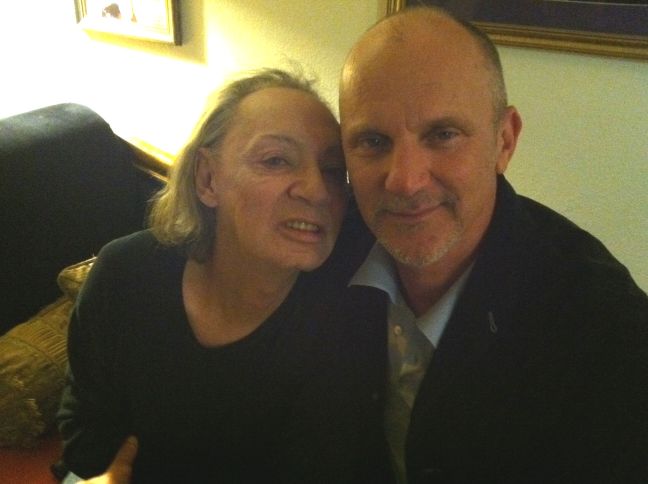
David McGough with Warhol Superstar, Holly Woodlawn
Los Angeles: March 29th 2012 - David McGough ParLA
FOR IMMEDIATE RELEASE:
West Hollywood hotspot boutique ParLA and DiLascia's Bakery played host to renowned Celebrity Photographer David McGough's west coast premiere of his "Larger than Life"
Portraits of the Stars.
McGough, a gifted veteran who is known on the east coast for collaborations with Andy Warhol as well as his long time partnership with The New York Post as staff photographer
was humbled by his standing room only turnout.
McGough held court in ParLa's front room as the crowd outside
wrapped around an entire block of Santa Monica Blvd.
Fans of McGoughs rock and roll work as well as serious art collectors were impressed not only by the crisp details of the portraits, they also scooped up smaller pieces and a group of
exclusive t shirts that were partnered in design by Patrick DiLascio and McGough.
Also featured was a 40 minute live performance by band ROYALUSH who promoted their new CD "It's only Kinky the First Time"
Among those in attendance were art critics and press from West Hollywood Confidential, The Hollywood Reporter, Daily Candy,
LA Lookbook and Otis Arts College who all wrote favorably of the event.
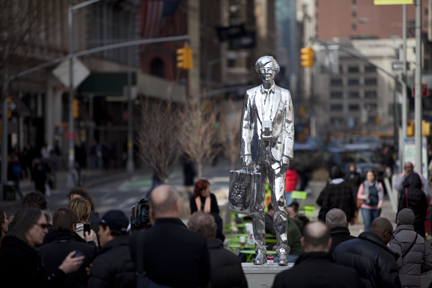
The Andy Monument
Union Square is one of New York City's most active social, cultural, and commercial centers. It is home to many well-known monuments, including statues of George Washington and Mahatma Gandhi. From 1968 to 1984 it was the location of Andy Warhol's Factory, where he and his collaborators reinvented the conventional artist's studio, producing silkscreen paintings, films, music, books, magazines, and more. With his Union Square Factory as a creative hub, Warhol became synonymous with the Downtown art scene.
Inspired by Warhol's art and life, Rob Pruitt (b. 1964, Washington DC) created The Andy Monument as a tribute to the late artist. It stands on the street corner, just as Warhol did when he signed and gave away copies of Interview magazine. Pruitt's sculpture adapts and transforms the familiar tradition of classical statuary. The figure is based on a combination of digital scanning of a live model and hand sculpting, its surface finished in chrome, mounted on a concrete pedestal. It depicts Warhol as a ghostly, silver presence: a potent cultural force as both artist and self-created myth. As Rob Pruitt observes, "Like so many other artists and performers and people who don't fit in because they're gay or otherwise different, Andy moved here to become who he was, to fulfill his dreams and make it big. He still represents that courage and that possibility. That's why I came to New York, and that's what my Andy Monument is about."
Nicholas Baume
Director & Chief Curator, Public Art Fund
download press release
Sponsors
Major support provided by Con Edison, Rebecca & Marty Eisenberg, Katherine Farley & Jerry I. Speyer, and Holly & Jonathan Lipton.
Additional support from Gavin Brown's Enterprise, New York, and the New York City Department of Cultural Affairs, in partnership with the City Council.
Made possible through the cooperation of the Union Square Partnership and the New York City Department of Transportation.
Special thanks to Mayor Michael R. Bloomberg; First Deputy Mayor Patricia E. Harris; Parks and Recreation Commissioner Adrian Benepe; Cultural Affairs Commissioner Kate D. Levin; New York Department of Transportation Commissioner Janette Sadik-Kahn; and Jennifer E. Falk, Executive Director, Union Square Partnership. Photographs by David McGough.
The Union Square Partnership is the leading advocate for the Union Square-14th Street community, working collaboratively with area residents, businesses, and cultural and academic institutions to ensure the district's continued growth and success. For more information, please visit www.unionsquarenyc.org.
As part of the New York City Department of Transportation's (DOT) "World Class Streets" initiative, the agency's Urban Art Program works with community-based and not-for-profit organizations to install murals, sculptures and other art forms in plazas and on medians, triangles, sidewalks, jersey barriers and construction fences around the City for up to 11 months. For more information, visit www.nyc.gov/urbanart.
Andy Warhol
Andy Warhol was born Andrew Warhola on August 6, 1928, in a two-room row house apartment at 73 Orr Street in Pittsburgh. His parents, Carpatho-Rusyn immigrants Andrej and Julia Warhola, had three sons. Andy was their youngest.
Warhol attended Carnegie Institute of Technology (now Carnegie Mellon University) from 1945 to 1949. He earned a Bachelor of Fine Arts degree in Pictorial Design with the goal of becoming a commercial illustrator. During these years he worked in the display department at Horne's department store.
Soon after graduating, Warhol moved to New York City to pursue a career as a commercial artist. His work debuted in Glamour magazine in September 1949. Warhol became one of the most successful illustrators of the 1950s, winning numerous awards. He had a unique, whimsical style of drawing that belied its frequent sources: traced photographs and imagery.
In the late 1950s, Warhol began to devote more energy to painting. He made his first Pop paintings, which he based on comics and ads, in 1961. The following year marked the beginning of Warhol's celebrity. He debuted his famous Campbell's Soup Can series, which caused a sensation in the art world. Shortly thereafter he began a large sequence of movie star portraits, including Marilyn Monroe, Elvis Presley, and Elizabeth Taylor. Warhol also started his series of &lddquo;death and disaster” paintings at that time.
Between 1963 and 1968 Warhol worked with his Superstar performers and various other people to create hundreds of films. These films were scripted and improvised, ranging from conceptual experiments and simple narratives to short portraits and sexploitation features. His works include Empire (1964), The Chelsea Girls (1966), and the Screen Tests (1964-66).
Warhol's first exhibition of sculptures was held in 1964. It included hundreds of replicas of large supermarket product boxes, including Brillo Boxes and Heinz Boxes. For this occasion, he premiered his new studio, painted silver and known as "The Factory". It quickly became "the" place to be in New York; parties held there were mentioned in gossip columns throughout the country. Warhol held court at Max's Kansas City, a nightclub that was a popular hangout among artists and celebrities. By the mid-1960s he was a frequent presence in magazines and the media.
Warhol expanded into the realm of performance art with a traveling multimedia show called The Exploding Plastic Inevitable, which featured The Velvet Underground, a rock band. In 1966 Warhol exhibited Cow Wallpaper and Silver Clouds at the Leo Castelli Gallery.
Warhol self-published a large series of artists' books in the 1950s, but the first one to be mass-produced was Andy Warhol's Index (Book), published in 1967. Two years later he co-founded Interview, a magazine devoted to film, fashion, and popular culture. Interview is still in circulation today.
In 1984, Warhol collaborated with the young artists Jean-Michel Basquiat, Francesco Clemente, and Keith Haring. Warhol returned to painting with a brush for these artworks, briefly abandoning the silkscreen method he had used exclusively since 1962.
In the mid-1980s his television shows, Andy Warhol's T.V. and Andy Warhol's Fifteen Minutes were broadcast on New York cable television and nationally on MTV. He created work for Saturday Night Live, appeared in an episode of The Love Boat and produced music videos for rock bands such as The Cars. Warhol also signed with a few modeling agencies, appearing in fashion shows and numerous print and television ads.
Warhol was a prolific artist, producing numerous works through the 1970s and 1980s. His paintings, prints, photographs, and drawings from this period include: Mao, Ladies and Gentlemen, Skulls, Hammer and Sickles, Shadows, Guns, Knives, Crosses, Dollar Signs, Zeitgeist, and Camouflage. Warhol's final two exhibitions were his series of Last Supper paintings, shown in Milan and his Sewn Photos (multiple prints of identical photos sewn together in a grid), exhibited in New York. Both shows opened in January 1987, one month before his death.
Excerpted from The Andy Warhol Museum's website. Read more at www.warhol.org
SMASH HIS CAMERA Kicks Off HBO Doc's Film Summer Series, Airs 6/7
Monday, June 7, 2010
Jackie Onassis sued him. Marlon Brando broke his jaw. To the people he pursued, legendary paparazzo Ron Galella was a bandit stealing their images, yet he created some of the most iconic celebrity images of the modern era. Over the course of a 50-year career marked by perseverance, Galella has been praised and vilified for his pioneering work in hit-and-run celebrity photography, sparking a fierce debate about privacy versus free speech that continues to this day. A 2010 Sundance Film Festival winner for Best Director, SMASH HIS CAMERA looks at both sides of Galella's controversial story when it debuts MONDAY, JUNE 7 (9:00-10:30 p.m. ET/PT), exclusively on HBO.
Other HBO playdates: June 7 (5:25 a.m.), 10 (4:30 p.m., 12:30 a.m.), 12 (5:00 p.m.), 18 (9:30 a.m.) and 20 (noon)
HBO2 playdates: June 9 (8:00 p.m.) and 15 (4:30 p.m.)
Beginning with SMASH HIS CAMERA, HBO Documentary Films presents another weekly series this summer, debuting a provocative new special every Monday through Aug. 9. Other June films include "For Neda" (June 14), "Gasland" (June 21) and "Kevorkian" (June 28).
Acclaimed documentarian Leon Gast (the Oscar�-winning "When We Were Kings") turns the camera on self-described paparazzo superstar Ron Galella to reveal a man as fascinating as any of his famous subjects. Taking its name from an order Jacqueline Kennedy Onassis issued to her security team, SMASH HIS CAMERA chronicles Galella's meteoric career as a notorious guerilla photographer and offers a thoughtful examination of the nature of fame, the relationship between celebrities and their chroniclers, and the delicate balance between privacy and freedom of the press over the past 30 years.
Galella revisits old haunts and shares war stories about Michael Jackson, Princess Diana, Brad Pitt and Angelina Jolie, ElizaBeth Taylor and Richard Burton, Robert Redford and other superstars who tried and failed to escape his lens. He proudly recalls the night Marlon Brando broke his jaw with one punch, knocking out five teeth in the process. Unafraid of the limelight himself, Galella donned a football helmet for his next encounter with the actor, and invited a photographer friend to document the outcome.
But no other subject caught his imagination (or the public's) like former first Lady Jacqueline Kennedy Onassis. From 1967 until 1982, Galella pursued her with a determination bordering on obsession. When his attention grew overwhelming, she instructed her Secret Service detail to prevent him from photographing her and her children.
In 1973, Galella filed a harassment suit against Onassis, alleging she was preventing him from doing his job. Onassis filed a countersuit and the epic legal battle that followed inspired an ongoing debate over the privacy of public figures. Ironically, his photographs became iconic images of Mrs. Onassis, some of them depicting "Jackie at her most fetching," as gossip doyenne Liz Smith says in the film.
In addition to Liz Smith, SMASH HIS CAMERA features interviews with photojournalist Harry Benson, visual artist Chuck Close, Vanity Fair editor GrayDon Carter, Thomas Hoving, former director of the Metropolitan Museum of Art, and attorneys on both sides of the historic legal battle, among others.
Named after movie idol Ronald Colman, Ron Galella began his career as a U.S. Air Force photographer before his increasingly creative methods of cornering the famous and infamous made him a household name. In the film, he happily shares the secrets of his success, such as hiding in bushes, high-speed car chases, outlandish disguises and strategic bribes. Among his unorthodox words of advice for aspiring paparazzi: "sneak in" to high-profile events, "dress right" for the occasion, "forge credentials" and the most effective technique in his playbook - surprise the subject and capture the real emotion of the moment.
SMASH HIS CAMERA is a portrait of an endlessly contradictory American original who still jumps barriers to get that exclusive photo at age 77. Galella's archive contains approximately three million images, while his pictures are shown in New York galleries, housed in the Permanent Collection of the Museum of Modern Art and collected in coffee-table books, as well as being sought-after by collectors. Whether he is simply "the price tag of the First Amendment" or a serious photojournalist, Ron Galella is a larger-than-life figure.
In conjunction with the debut of SMASH HIS CAMERA, New York's Clic Gallery will present a retrospective of Galella's most legendary photographs, entitled "Smash His Camera: The Notorious Photographs of Ron Galella," from June 1-30.
HBO Documentary Films presents a Got The Shot Production film; executive producers, Jeffrey Tarrant, William Ackman, Daniel Stern; produced by Linda Saffire and Adam Schlesinger; directed by Leon Gast; original music by Craig Hazen and David Wolfert; director of photography, Don Lenzer; creative consultant, Roger Rosenblatt; edited by Doug Abel, A.C.E.
SMASH HIS CAMERA will air on HBO June 7th, 2010.
The Bradenton Times
March 6, 2010
POST
POP Show

Opening Night
Saturday,
March 6th
* 5-9PM
Live
Music: Gumbo Boogie Band

You've
likely heard about or are familiar with Andy Warhol and the Pop Art movement he defined. But what is Post Pop? Palmetto Art Center (PAC) will showcase POST POP artworks by world-renowned and talented local
artists.
One
of the many Post Pop artists on display is David McGough. Influenced
while photographing Warhol, McGough's photographs
have graced the pages of magazines such as Vanity Fair, Vogue,
Playboy, Newsweek, Life Magazine, Time, People, Rolling Stone,
Paris Match, and more. McGough
has had more than 100 images published on the cover of The New York
Post. Although
celebrated as a photographer, David McGough has directed his energies
to painting, and original mixed-medium art.
Post
Pop will also feature:
Carrie
Price Whaley's distinctively bright and colorful friendly creature
paintings
Layla
Copeland's elaborate enclosed environments creating an exploration
of Hollywood and the popular culture our society follows.
Hugo
Porcaro distinctive casually-cartoonist style artwork which
can be found in numerous collections nationally including work
on display in The Clinton Library.
Bill
Martin's fabricated, emotional black and white photographic images
that are forced to survive in a Technicolor, avant Pop, Post
Modern world.
FREE
admission for The POST POP Show's Opening Nite
Show
Runs through March 30th
The
PAC
907
5th
Street West
Monday-Friday:
10AM 2PM, Saturday 11AM 3PM (Closed Wednesdays)
www.PalmettoArtCenter.com
Art Center Sarasota presents
A Talk with Photographers
January 8, 2010 10am - 12pm
Fee: $5

Art Center Sarasota
707 N. Tamiami Trail
Sarasota, FL 34236
941-365-2032
www.artsarasota.org
David McGough (Iconic Celebrities) and Jimmy Peters (Florida Cowboys)
ART CENTER SARASOTA is hosting a talk with David McGough, photographer of iconic celebrities,
who will speak on his exciting career shooting iconic superstars around the world and Jimmy Peters,
who will relate stories of his interest and observation through photography of the little-known world
of Florida cowboys. This event is open to the public.
David McGough studied photography at Pratt Institute in New York City, graduating in 1979. During his years at Pratt he documented the bourgeoning punk rock scene in lower Manhattan, photographing The New York Dolls, Ramones, Talking Heads and others at downtown clubs such as CBGB. David became staff photographer for Rock Magazine and a contributor to Andy Warhol's Interview. McGough started DMI Photo in 1980 and became one of New York's most important photojournalists. Hired by the New York Post, David covered the daily celebrity scene and garnered over 100 page-one photographs. If there was an important event in the city, you could be certain that McGough was there recording it for the Post's 1 million daily readers. McGough's photographs have appeared inside and on the cover of many major publications including Life, Vanity Fair, New York Magazine, People, Esquire, Us, Paris Match, Rolling Stone, Time, Newsweek as well as in books, television and film. McGough and his mentor Andy Warhol had a close relationship for over 10 years. Before his death in 1987, Warhol declared McGough "the greatest!" David is on the creative Board of Directors for The Sarasota Film Festival and has helped the festival to grow to become one of the ten most important film festivals in the country.
http://davidmcgough.com
Celebrity photographer now paints in Anna Maria
November 20, 2009
Bradenton Herald - Chances are, if you've picked up a magazine, newspaper or book having anything to do with celebrities, you've seen a David McGough photo.
His portfolio of the famous -- featured in publications such as Vanity Fair, People Magazine, Rolling Stone and an assortment of books and films -- includes David Bowie, Jackie Kennedy, Andy Warhol and Michael Jackson.
High-profile presidents and princesses.
Actors and actresses.
The list goes on and on.
McGough, an Anna Maria Island resident who lives in a quaint, fashionable home overlooking the Gulf of Mexico, has some of those celebrity photos on display at ArtCenter Sarasota in conjunction with its newest photography exhibition -- the sixth annual Florida Open Juried Photography Exhibition, which runs through Jan. 9. On display is a 16-piece collection of music idols. It's just a taste of the thousands of photos he's shot in a career that spans more than 25 years.
The 50-year-old photographer has a lifetime of tales to go with them.
"They are beautiful, iconic photographs that will speak to our memories," said Fayanne Hayes, the center's executive director. "Some of our newest photographers can learn from one of the greats."
Photographic memories
These days, though, McGough, who is also a musician, often sets his camera aside to pick up a paint brush.
The former Pratt Institute student has a collection of large, colorful paintings he's created that hang in his gulfside home. He's excited about his newest art project, using photo images on canvas and then painting around them. They will be very Warhol-ish, he said.
Warhol, the prolific pop artist icon of his time, was a friend and mentor to McGough. He appears in many of his photos. McGough was honored when Warhol asked him to submit a photo project for his publication, Interview Magazine, in 1979.
Their friendship began via the United States Postal Service. While living in New York, McGough, a New Jersey native, constantly sent Warhol his work. For a while, he never got a response back.
Then, they ran into each other at parties.
"I would see him a couple times a week," McGough said. "He was a kind of golly-gee type of guy. For being so hip in so many ways, he loved celebrity. He was fascinated by it all. He really felt like he was so lucky to be around the celebrities -- the bigger, the better. He loved big stars and he loved to be around them. He'd get excited like a little kid."
McGough has been mystified by fame, too, but not in the same way as Warhol. He's literally read thousands of books on the subject. His photos and stories have appeared in many of them, including biographies of stars such as Mick Jagger and Elizabeth Taylor. McGough worked for Taylor for five years, snapping behind-the-scenes photos of her on the road.
His career began as a college freshman at the Columbus College of Art and Design. A local newspaper in Ohio asked him to shoot a Dan Folgelberg concert at Ohio State University.
After that, McGough realized he could merge the two things he loved most in life -- music and photography.
After graduating from Pratt in 1979, he covered New York's gritty punk rock scene, covering Lou Reed, Talking Heads, the Ramones and others. He shot rock stars in New York clubs and later branched out to film stars. He was doing so well that he started his own freelance company, DMI Photo. His aggressiveness for his craft got him noticed by The New Post and other publications.
In the early 1980s, there were about 10 photographers who made a name for themselves covering the stars.
Only 10. This was before MTV, the Internet, an onslaught of cable networks and celebrity magazines -- what McGough calls the evolution of our celebrity- obsessed culture.
The heightened obsession bothers McGough sometimes. Most people in America seem to know more about Lindsay Lohan than Iraq.
"It's kind of sad to see," he said.
Celebrity through the lens
Behind the camera lens, watching celebrities in the limelight, McGough discovered the makings behind these larger-than-life industry machines. At their core, the stars were just normal people, who worked hard to craft their image. And the stranger, more outlandish or risque the better, because it would keep celebs in the spotlight. The key was to make it look like normal behavior for them, McGough said.
As he talked, Michael Jackson came to mind.
The photographer met Jackson just before his legendary solo career -- before the surgeries, before Neverland. McGough said he was "a sweet, shy kid," who later tried his best to be "weird."
The tape around his fingers, the veils he wore -- it was part of an image; A persona he tried to create for the public.
"His goal was to be as weird as he could be," McGough said. "He thought that he would keep his name in the news. And it worked up until a point and then it backfired because people got sick of the weirdness."
Manipulating the media is a card many celebrities play, McGough said. He's seen it too many times. Scandals, leaked photos, tapes. Celebrities will often tip off the media about their unannounced appearances. It's just part of the game, he said.
McGough's roughest encounter: He got punched once by Ryan O'Neal, Farrah Fawcett's long-time partner, outside of New York's popular Elaine's restaurant in 1980. O'Neal hit him and broke his camera.
The photographer particularly enjoyed covering the Monaco royal family, who often visited New York. Photos of them were highly sought among the international media. Princess Caroline, the daughter of actress Grace Kelly, was one of the most beautiful people McGough said he's ever photographed.
And when it came to classy, Jackie Kennedy broke the mold in McGough's eyes. He took many photos of her, too.
"She was beyond classy," said McGough, who worked with paparazzi god Ron Gelella, who found fame through her photos. "She really was one of those very special people that really affected our culture. These first ladies now really all want to be Jackie, especially the one we have right now. But clearly, they all don't hold a candle to her."
When it comes to the world of celebrity, four deaths shook McGough.
The first was Warhol, who died after a gall bladder surgery in 1987. McGough framed a headline from his death that appeared in the New York publication. It reads: "Andy Warhol Dead at 58" and sits on a shelf in his home.
The second, Princess Grace, who died in a tragic car accident in 1982.
Both deaths were unexpected, he said.
Then there was Jackie Kennedy, who died of cancer in 1984.
"It really was an end of an era," McGough said. "There was no one that was going to come up and replace them. You could say that about anybody really, except that these three were really one of a kind. They weren't actors. They weren't movie stars. They had more cultural impact."
The other death was Princess Diana in 1997, which changed the way celebrity photographers were viewed by the public.
"They had nothing to do with her death," he said.
But since then, things haven't been the same for his industry, he added.
Expanding his talents
McGough sold the rights to his extensive photo collection to Time Life. The portfolio features millions of celebrity photos.
When he moved to Anna Maria 10 years ago, he found time to paint. His work hangs at the Village of the Arts' Divine Excess Gallery. More will be showcased in an upcoming exhibit at the Palmetto Art Center in March.
Though he enjoyed the hustle and bustle of celebrity photography, McGough finds new solace in painting.
"I just like paint," he said. "I like to put paint on canvas and move color around. It's really a very liberating feeling."
Still, a rush of memories flow back when he thinks about the first photo he ever took -- before being a professional photographer entered his mind.
It was of the Rolling Stones as they were leaving a concert in New York.
"I still have that picture," McGough said. "That sort of planted the seed for me -- that this would really be fun and exciting."
And it has been.
IT'S 'B' SEASON! SECOND-STRING STARS FINALLY GET TO PLAY
LIBBY CALLAWAY
Posted: 12:00 AM, February 27, 2003
LET'S hear it for the B-list.
Even while the harsh winter has been keeping top-tier revelers like Nicole Kidman away from parties, semi-celebs are out in force at premieres, store openings, award shows - you name it.
Go-to gals Samantha Cole, Jamie-Lynn Sigler and Deborah Gibson can be counted on to turn up wherever flash bulbs are popping.
You know things are slow when Izabella Miko - who starred as Cammie in the film "Coyote Ugly" - is one of the most photographed stars in New York. "You've got to hand it to them," says Mark Getty, who runs the photo agency Getty Images. "They show up at parties and they usually stick around. And in a down time, at least they give us something to shoot."
If it weren't for Miko and her ilk, the city's paparazzi might be on food stamps.
"There are only about 50 A-list stars in New York," says David McGough, who runs the DMI photo agency. And when they don't turn up - it's hello Star Jones!
How do you spot a B-lister? They're:
* Everywhere. Whether it's a party for the New York City Ballet at the Central Park Boathouse or a ribbon-cutting at a new Gristedes in Chelsea.
* Always on time. That way, before the big celebs arrive, they can monopolize the photographers when they're hungriest.
* Usually overdressed. Who's the buxom blonde wearing a purple boa at a cocktail party full of suits in suits? Eight out of 10 times, she's a B-lister; the other two, she's someone's mistress.
* In love with designer labels. Especially if designers give them the clothes for free. (And frankly, if you know Nicole ain't coming, why not let Jamie-Lynn Sigler wear your stuff?)
* Obsessed with A-listers. And they'll go to any extreme to be photographed talking to one.
* Obsessed with other B-listers. And they'll go to any extreme not to be seen talking to them.
* Always grabbing attention. Some of their favorite gimmicks include: small dogs, flashy diamonds (borrowed), revealing clothes or outrageous makeup, a date who's gotten a lot of play in the media.
The paparazzi shoot back
ANN OLDENBURG
Posted: 03:04 PM ET, July 8 1999
They've slithered on their bellies through the tall grass. They've disguised themselves as waiters. They've buzzed weddings in rented helicopters and stalked offshore getaways in chartered boats.
This is the life of the professional paparazzi - that breed of celebrity photographer both the public and movie stars say they despise while, respectively, hungering for their exclusive wares and using them to advance their careers.
On Monday, in the wake of worldwide criticism of the role of paparazzi in the death of Princess Diana - and with evidence mounting that the driver of her vehicle was drunk - paparazzi came out swinging.
"Photographers were not the cause of the accident," says David McGough, who runs DMI, a Los Angeles photo agency that does not use guerrilla tactics. "There were other causes: the drunk driving, the thrill of the chase. I've seen how the cat-and-mouse game is played. The reason they're both dead is he drove 90 miles an hour in an area where he should have been doing 30."
"For this Di incident," says Rob De Marco, photo editor of The Star tabloid, "the press isn't to blame at all."
Still, anger at the paparazzi is growing. Officials in France, England and Germany called for tougher privacy laws and tougher penalities for journalists who violate them.
In the midst of the worldwide outcry, it was probably inevitable that paparazzi photos from the crash would be published. Monday, Germany's largest-circulation newspaper, Bild Zeiturn, printed shots that faintly showed what seemed to be two slumped bodies in the car. They're the type of photos from the scene that National Enquirer editor Steve Coz had called for a ban against.
Since the 1960s, when Fellini's La Dolce Vita film first used the term Paparazzo as the name of a pesky photographer character, lensmen in search of celebrities have become increasingly aggressive, raising the stakes in an already dangerous game to get the prized shot of the moment.
But Diana's death takes to a new level concerns over whether public people have a right to at least a modicum of a private life.
Sunday's tragic accident in Paris also shines an uncomfortable spotlight on a celebrity-hungry society. Was the public, in supporting these glimpses into the lives of the rich and famous, somehow a silent accomplice in her death?
Diana had long been a target. But she, too, had learned to use the press - a fact that some plainly pointed out.
"Celebrities want to feel important," says the Star's De Marco. "Believe me, they like it, they like the publicity."
"Diana was not killed by the press. She was killed by the morbid love of her subjects," wrote Sergio Romano, a former Italian ambassador to the United States and Russia, in an editorial Monday in Italy's La Stampa newspaper.
"It is difficult in these hours, when every television is showing images of the princess . . . to defend a category which certainly many times has lost itself to excesses," said an editorial in Italy's Il Giornale newspaper. "But if those boys who waited outside the Ritz are to blame, all of us are."
It's a vicious, confusing circle and, as Chip Hires, an American who shoots for Gamma photo agency says, "a drama" with lots of players.
"The market is there. People buy the magazines. They have the taste, and editors push it. There's a whole chain: owners, editors, readers. It's just the silliness of human nature."
And it's been that way since paparazzo Ron Galella was taken to court by Jackie Onassis and ordered to stay away.
Consequently, tabloids have paid bigger and bigger fees for those shots. The photo published in Germany reportedly was being offered at $1 million.
Just three weeks ago, The Globe paid $210,000 for intimate shots of Di and boyfriend Dodi Fayed kissing in their bathing suits.
On Monday, while some of the paparazzi fought back, many clammed up.
In California, Alan Zanger, one of the more aggressive and well-known paparazzi, said, "I'm not talking. Not anymore. Not a word. I just got slammed by some paper."
He added: "I'm sorry this whole thing happened. But at least the truth is coming out." He was referring to the news that Diana's driver had a high blood-alcohol level at the time of the crash.
In the end, some paparazzi say, the blame doesn't matter. The money does.
Phil Ramey, another Los Angeles-based paparazzo, earns six figures annually. He got $500,000 just for photos of Lisa Marie Presley's baby.
He has posed as a waiter for a snapshot of Princess Stephanie with a boyfriend in a Beverly Hills restaurant. And he scaled the wall of a Tahiti mental hospital for a photo of Cheyenne Brando, Marlon's daughter. He even once rented a yellow submarine to stake out Princess Diana on vacation.
"It's very competitive out there," he told the Associated Press last year. "People without the skill and expertise are ruining it for us and getting the celebrities agitated."
Very agitated.
Monday, Elizabeth Taylor called the photographers "murderers."
She was one of many stars condemning the guerrilla tactics of the lensmen. Michael Jackson and Woody Harrelson issued statements; John Travolta and Sylvester Stallone spoke out; Tom Cruise was among the first to talk, telling CNN that the photographers' behavior was "disgusting."
Arnold Schwarzenegger said he has felt like a hunted animal when around them.
"Many of us in public life have had the chilling experience of being chased," he said. "As long as that lawless atmosphere exists and publications dangle huge bounties for such photos, these kinds of tragedies will happen."
George Clooney instituted a boycott against Hard Copy's "stalkerazzi" footage - video taken by cameramen who stalk, taunt and provoke stars to get a reaction.
"They cross a line," he said then. And his boycott was effective. Hard Copy stopped buying stalkerazzi tape.
Clooney's representative, Stan Rosenfield, said Monday, "What the public does not realize . . . is the violent degree of what goes on. They see that polite line on the red carpet."
Rosenfield says the first step in stopping the paparazzi is to "take away the money. . . . In many ways, Di's tragedy was not an aberration, it was going to happen sooner or later."
Editor salutes the paparazzi for punishing the famous and making them normal
June 18, 1992
They buzz around celebrities like bees around honey, and New York's swarm of paparazzi can pack a sting.
Jane Fonda topless. Sophia Loren topless. Liz Taylor and Richard Burton embracing offscreen while she was still married to Eddie Fisher. Who can forget Jackie Onassis, so dogged by Ron Galella that she got a court order to keep him at least 25 feet away from her?
American Photo magazine editor David Schonauer, whose current issue features a look at paparazzi, admires the men and women who "pump up the celebrities and keep them in the news, but also show them as normal human beings.
"Paparazzi sort of punish the rich and famous for being rich and famous, and that's not a bad thing. We give celebrities fame and wealth; in a weird way, they belong to us. We want them, but we extract a price for their celebrity. Paparazzi are the people we send out to extract payment."
New York Daily News staff photographer Richard Corkery has reservations. "Celebrities are entitled to some privacy," he says. "When photographers lay outside their homes or haunt them day and night, that's too much. So is provoking a celebrity to get a headline-grabbing action shot. That's ugly."
But, he adds, any VIP at a public event who says "no pictures" is "in the wrong."
Mr. Corkery snapped The News' famous pre-dawn shot of John F. Kennedy Jr.'s inebriated birthday pals brawling with photographers, and he once had a friend smuggle his cameras past heavy security into a party at Regine's so he could shoot Princess Caroline dancing with boyfriend Philippe Junot.
When Robert Redford premiered "The Natural" in New York, Mr. Corkery remembers, "he snuck in the back door. I was there, waiting. When he saw the camera, he ducked his head -- and walked right into a brick wall. What an opening!"
For most paparazzi, all this is just a job. Waiting long hours to get the right shot. Being penned behind ropes or caught in a mob of shoving competitors. Getting attacked by such ever-irate celebrities as Sean Penn. Getting hassled by security people. Getting escorted outside. And, after all that, having to process and then sell the film.
Says Bettina Cirone, who has spent 22 years on the beat: "I work 18 hours a day. Deadlines are so urgent. I gave People a negative of Ben Vereen backstage at 'Jelly's Last Jam' with Greg Hines, Sigourney Weaver and Mike Douglas the night before his accident. They decided against using it, but by then, it was too late to get into any newspapers."
Ms. Cirone believes that some security people target women photographers rather than their "tougher" male counterparts. Still, that doesn't stop her. She got Kim Basinger and Alec Baldwin necking. She got Madonna weeping after a performance of "A Streetcar Named Desire," despite attempts by the Madonna bodyguards to block the shots.
David McGough, co-chief of DMI photo agency, and the man who took the famous shot of Woody Allen hiding behind a La Grenouille menu -- but being reflected in a mirror -- believes Andy Warhol helped create the chaos with his "15 minutes of fame for everyone" theory.
"Today," says Mr. McGough, "even models, who were once just pretty women, are now stars."
When the camera clicks, it can mean big bucks. Russell Turiak says his photos of new parents John McEnroe and Tatum O'Neal in the hospital with their baby was an exclusive that earned him $100,000.
Hottest pictures now?
Royalty, the paparazzi agree. Fergie. Di.

Paparazzo pioneer Ron Galella: The man behind the camera